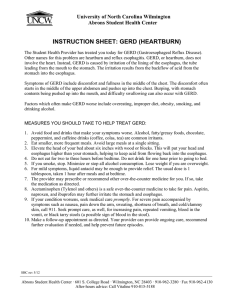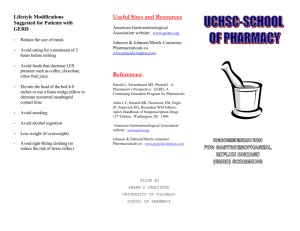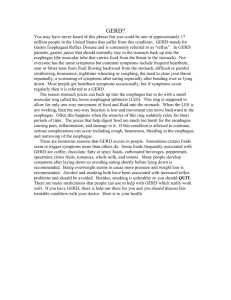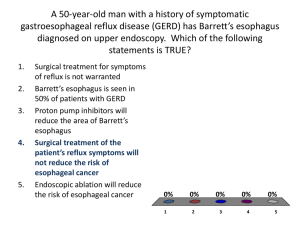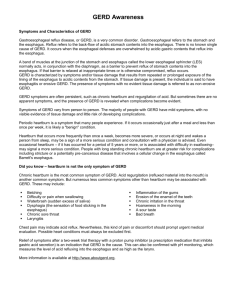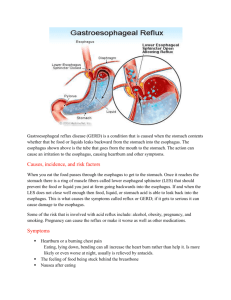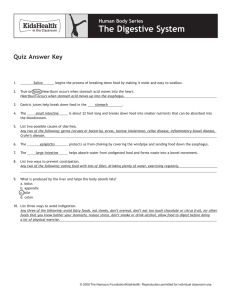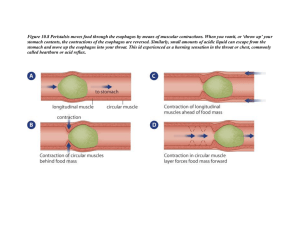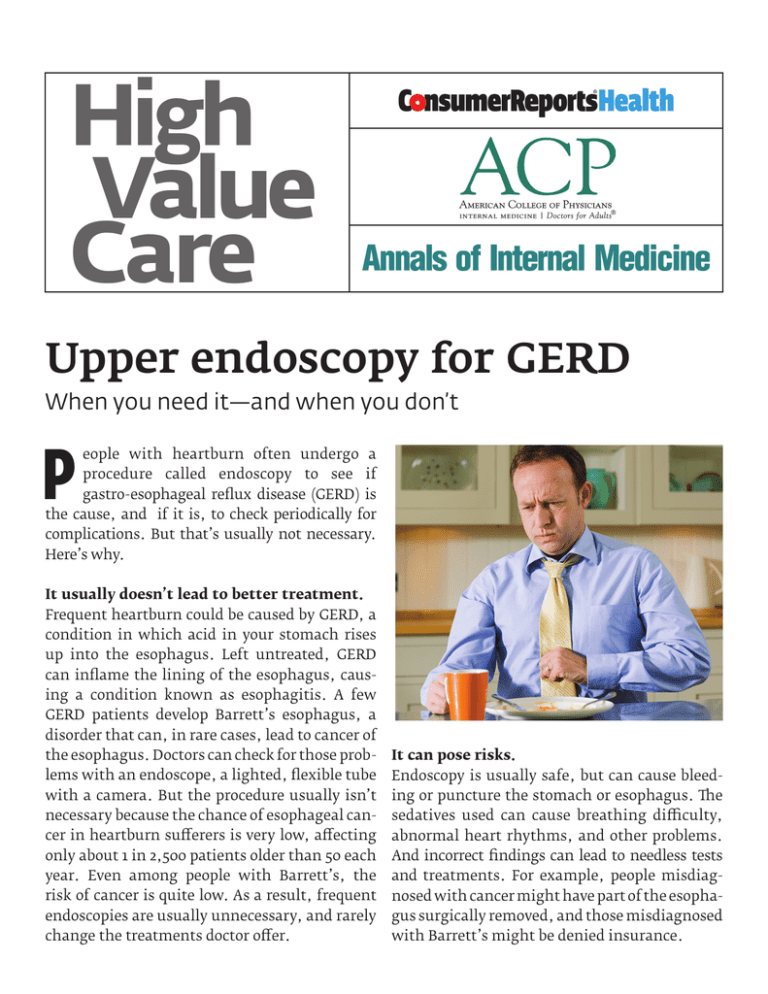
High
Value
Care
Upper endoscopy for GERD
When you need it—and when you don’t
P
eople with heartburn often undergo a
procedure called endoscopy to see if
gastro-esophageal reflux disease (GERD) is
the cause, and if it is, to check periodically for
complications. But that’s usually not necessary.
Here’s why.
It usually doesn’t lead to better treatment.
Frequent heartburn could be caused by GERD, a
condition in which acid in your stomach rises
up into the esophagus. Left untreated, GERD
can inflame the lining of the esophagus, causing a condition known as esophagitis. A few
GERD patients develop Barrett’s esophagus, a
disorder that can, in rare cases, lead to cancer of
the esophagus. Doctors can check for those problems with an endoscope, a lighted, flexible tube
with a camera. But the procedure usually isn’t
necessary because the chance of esophageal cancer in heartburn sufferers is very low, affecting
only about 1 in 2,500 patients older than 50 each
year. Even among people with Barrett’s, the
risk of cancer is quite low. As a result, frequent
endoscopies are usually unnecessary, and rarely
change the treatments doctor offer.
It can pose risks.
Endoscopy is usually safe, but can cause bleeding or puncture the stomach or esophagus. The
sedatives used can cause breathing difficulty,
abnormal heart rhythms, and other problems.
And incorrect findings can lead to needless tests
and treatments. For example, people misdiagnosed with cancer might have part of the esophagus surgically removed, and those misdiagnosed
with Barrett’s might be denied insurance.
It can be expensive.
The procedure typically costs about $1,130 plus a
fee for anesthesia, according to HealthcareBlueBook.com. And even insured patients may have
substantial co-pays and deductibles.
So when is it warranted?
People with GERD don’t need endoscopy unless:
• Symptoms remain after four to eight weeks of
a proton pump inhibitor (PPI) such as esomeprazole (Nexium), lansoprazole (Prevacid and
generic), or omeprazole (Prilosec and generic).
• Severe inflammation of the esophagus persists
despite two months of PPI treatment.
• Heartburn occurs with anemia, difficulty swallowing, weight loss, frequent vomiting, vomiting blood, or black or red bowel movements.
• You have frequent difficulty swallowing, plus
a history of narrowing of the esophagus.
The test might also be appropriate if you are a
man 50 or older with GERD symptoms for more
than five years plus other risk factors such as
smoking or obesity. Most people who have
Barrett’s need endoscopy once every three to five
years. Those with early signs of cancer require it
more often. And those without Barrett’s usually
don’t need it repeated at all.
using this information
This information is provided for you to use in discussions with your healthcare provider. The content is for educational use only and is not a substitute
for professional medical advice, diagnosis, or treatment. Always seek the
advice of a qualified health-care provider about any medical condition.
Never disregard, avoid, or delay in obtaining medical advice from a healthcare provider because of something you have read in this report. Use of
this report is at your own risk. Consumer Reports, the American College of
Physicians, Annals of Internal Medicine, and their distributors are not liable
for any loss, injury, or other damage related to your use of this report.
This report is intended solely for consumers’ personal, noncommercial
use and may not be altered or modified in any way or used in advertising,
for promotion, or for any other commercial purpose. Special permission
is granted to organizations participating in the Consumer Reports health
communication program to disseminate free copies of this information in
print or PDF formats to individual patients, members, or employees. Learn
more at ConsumerHealthChoices.org or send an e-mail to HealthImpact@
cr.consumer.org.
Published by Consumer Reports © 2012 Consumers Union of U.S., Inc., 101
Truman Avenue, Yonkers, NY 10703-1057. All rights reserved. Developed in
cooperation with the American College of Physicians and Annals of Internal
Medicine as part of the High Value Care patient education program.
Portions of this report are derived from materials developed for the High
Value, Cost-Conscious Care Initiative of the American College of Physicians
and Annals of Internal Medicine and are used with permission. © 2012
American College of Physicians.
11/2012
Consumer Reports’ Advice
How should you
manage heartburn?
The following steps can help relieve
occasional heartburn as well as GERD:
• Make lifestyle changes.
Lose excess weight, stop
smoking, eat smaller meals,
don’t lie down for several
hours after eating, wear
loose-fitting clothes, and
limit how much alcohol you
consume. Resist foods and
beverages that can trigger
your heartburn, such as
chocolate, peppermint, coffee (with or
without caffeine), garlic, onions, and
fried, spicy, fatty, or tomato-rich food.
Sleep comfortably. Place wood blocks
under your bedposts to raise the head of
your bed 6 to 8 inches.
Control acid. Over-the-counter
antacids such as Maalox, Mylanta,
Rolaids, or Tums may ease heartburn. For
a stronger acid-reducer, try an H2 blocker
such as famotidine (Pepcid and generic)
or ranitidine (Zantac and generic).
Consider a PPI for GERD. Those drugs
relieve symptoms and heal the lining of
the esophagus in almost all sufferers. For
best results, take them 30 to 60 minutes
before a meal. Omeprazole and lansoprazole are sold over the counter, as low-cost
generics. If symptoms don’t improve after
two to four weeks, ask your doctor about
taking the dose twice a day. For our free
Best Buy Drug report on PPIs, go to www.
CRBestBuyDrugs.org and click on
“heartburn.”

